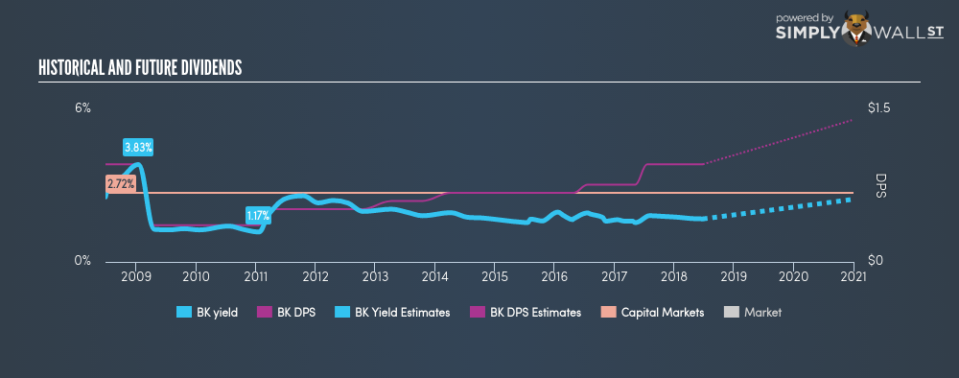Should You Buy The Bank of New York Mellon Corporation (NYSE:BK) For Its Dividend?

Dividends can be underrated but they form a large part of investment returns, playing an important role in compounding returns in the long run. The Bank of New York Mellon Corporation (NYSE:BK) has returned to shareholders over the past 10 years, an average dividend yield of 2.00% annually. Should it have a place in your portfolio? Let’s take a look at Bank of New York Mellon in more detail. See our latest analysis for Bank of New York Mellon
5 questions to ask before buying a dividend stock
Whenever I am looking at a potential dividend stock investment, I always check these five metrics:
Is it paying an annual yield above 75% of dividend payers?
Has it consistently paid a stable dividend without missing a payment or drastically cutting payout?
Has it increased its dividend per share amount over the past?
Can it afford to pay the current rate of dividends from its earnings?
Will it be able to continue to payout at the current rate in the future?
How well does Bank of New York Mellon fit our criteria?
The company currently pays out 22.64% of its earnings as a dividend, according to its trailing twelve-month data, which means that the dividend is covered by earnings. Going forward, analysts expect BK’s payout to increase to 27.04% of its earnings, which leads to a dividend yield of 2.08%. Furthermore, EPS should increase to $4.29. The higher payout forecasted, along with higher earnings, should lead to greater dividend income for investors moving forward.
If there’s one type of stock you want to be reliable, it’s dividend stocks and their stable income-generating ability. Not only have dividend payouts from Bank of New York Mellon fallen over the past 10 years, it has also been highly volatile during this time, with drops of over 25% in some years. This means that dividend hunters should probably steer clear of the stock, at least for now until the track record improves.
Compared to its peers, Bank of New York Mellon has a yield of 1.69%, which is on the low-side for Capital Markets stocks.
Next Steps:
If you are building an income portfolio, then Bank of New York Mellon is a complicated choice since it has some positive aspects as well as negative ones. However, if you are not strictly just a dividend investor, the stock could still offer some interesting investment opportunities. Given that this is purely a dividend analysis, I urge potential investors to try and get a good understanding of the underlying business and its fundamentals before deciding on an investment. I’ve put together three relevant factors you should look at:
Future Outlook: What are well-informed industry analysts predicting for BK’s future growth? Take a look at our free research report of analyst consensus for BK’s outlook.
Valuation: What is BK worth today? Even if the stock is a cash cow, it’s not worth an infinite price. The intrinsic value infographic in our free research report helps visualize whether BK is currently mispriced by the market.
Dividend Rockstars: Are there better dividend payers with stronger fundamentals out there? Check out our free list of these great stocks here.
To help readers see pass the short term volatility of the financial market, we aim to bring you a long-term focused research analysis purely driven by fundamental data. Note that our analysis does not factor in the latest price sensitive company announcements.
The author is an independent contributor and at the time of publication had no position in the stocks mentioned.

 Yahoo Finance
Yahoo Finance 
